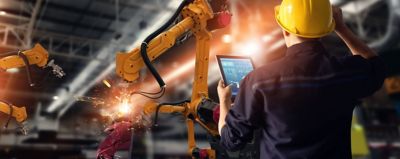You've likely come across compressed air in your life. It's an essential part of modern society. There are a lot of uses, including braking systems, power tools, automatic doors, and for medical, food and beverage applications. With that, it's worth answering the question "how does air compression work?" This article will do just that, by covering the following topics.
- An overview of compressed air
- How does air compression work?
- Air quality
- Common air compressors: piston and rotary screw
- Applications
Of course, if you find you still need more information, feel free to reach out. Our team will go over air compression and the types of equipment we offer. Read on below to start learning about air compression.
An overview of compressed air
Compressed air is an abundant resource. This is because it is just everyday air that's rapidly pressurized. Since this air is out of balance with atmospheric air, it comes out at high speeds. This creates force useful for applications like those stated above.
You'll find compressed air expressed in pounds per square inch (psi) or bar. Air compressors come in a range of pressure ratings to meet different needs. It's important to pay attention to psi or bar relevant to your application(s).
You’ll also want the right flow, expressed in cubic feet per minute (cfm), liters per second (l/s) or cubic meters per hour (m3/h). Investing in equipment that’s too big or too small can result in energy waste and inefficient operations. Your application(s) may not function properly without the right pressure and flow.
It’s also worth mentioning air treatment products including dryers, filters, and aftercoolers. This is because atmospheric air used for compression usually contains contaminants like dust and other particles. Additionally, during the compression process, this air typically goes through rapid temperature changes - resulting in water vapor. If you’re operating oil-injected equipment, traces of oil can also enter compressed air. These topics are covered more below.
How does air compression work?
Before we discuss air quality, it's important to answer the main question of this article - how does air compression work? As we've already explained, it's just pressurized ambient air. To create such conditions, the following happens.
- Air is sucked into an air compressor
- It is rapidly forced into a space smaller than the volume of air
- This air is typically stored for later use
There are different approaches to this simple principle. We cover two main types of compressors, piston and rotary screw, later in this article.
Air quality
Now that we've explained a bit about how air is compressed, it's worth diving into air quality. You'll find different classes, according to the ISO 8573-1 standard, depending on your application.
Like mentioned above, compressed air can contain dust, moisture, and oil. These can all impact air quality. When shopping for air treatment accessories and equipment, they'll be rated by ISO 8573-1 Class capabilities.
Oil-free vs. oil-injected
One point worth diving into is the difference between oil-free and oil-injected compressors. Since these machines generate heat, oil can be used as a coolant and lubricant for moving parts. Alternatively, there are oil-free solutions. With oil-injected compressors, oil microparticles can be found in compressed air. It's important to pay attention to this when considering your desired air quality class.
Air treatment
To improve air quality, there are treatment methods. The most common are dryers, filters, and aftercoolers. These each serve different functions, and shouldn't be used interchangeably. It's important to design a set-up with adequate treatment layers. As stated, the right solution depends on the ISO 8573-1 Class recommendation for your application(s).
Common air compressors: piston and rotary screw
We already pointed out the two common types of air compressors, piston and rotary screw. These machines have different working principles. One typically uses a motor to power a crankshaft for operating pistons, and the other involves two opposing rotors powered by an advanced engine. They’re both effective in producing compressed air. However, a rotary screw machine offers more engine options and energy efficiency capabilities.
Water vapor and dryers
We briefly mentioned the rapid temperature changes involved in the air compression process. This is important to note, as high heat is generally involved, resulting in water vapor. An air compressor dryer counteracts this humidity, thus preventing corrosion, rust, and microorganisms in your equipment, as well as cleaning the air.
You can learn more about this in our articles on dryers.
Fixed speed vs variable speed drive (VSD)
One of the biggest differences between piston and rotary screw machines is fixed speed vs. variable speed drive (VSD). Piston compressors are only available in fixed-speed models, while there are VSD rotary screw machines.
The main benefit is that fixed speed models only provide one, maximum, motor speed whereas VSD machines adapt their speed depending on air flow. This allows for increased efficiency.
VSD machines can save up to 45% on energy costs. This is quite significant considering electricity expenses make up the majority of an air compressor's operational budget.
Applications
As this article states, compressed air is useful for a variety of applications. The right set-up for you depends on your specific industry. Here are just a few where an air compressor is beneficial.
- Pneumatic tools
- Food and beverage
- Medical
- Pharmaceutical
- Automotive
- Construction
If you'd like more information on anything covered in this article, contact us today. We're happy to help.
Get tailored advice
Still have questions after reading? Our expert is ready to help you make sense of it all and guide you to the best solution.
Write to an Expert Today – Get the answers you need.





